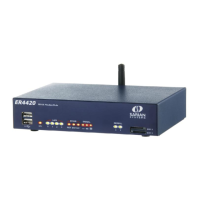Virtual Routing and Forwarding (VRF)
Digi TransPort User Guide 387
Configuring VRFs
To configure one or more VRFs, perform these steps:
Step Command Purpose
1 Switch# configure terminal Enters global configuration mode.
2 Switch(config)# ip routing Enables IP routing.
3 Switch(config)# ip vrf vrf-name Names the VRF and enters VRF configuration mode.
4 Switch(config-vrf)# rd route-distinguisher Creates a VRF table by specifying a route
distinguisher. Enter either an AS number and an
arbitrary number (xxx:y) or an IP address and
arbitrary number (A.B.C.D.y).
5 Switch(config-vrf)# route-target
{export|import|both}
route-target-ext-community
Creates a list of import, export, or import and export
route target communities for the specified VRF.
Enter either an AS number and an arbitrary number
(xxx:y) or an IP address and arbitrary number
(A.B.C.D.y).
Note: This command is effective only if BGP is
running.
6 Switch(config-vrf)# import map
route-map
(Optional) Associates a route map with the VRF.
7 Switch(config-vrf)# interface
interface-id
Enters interface configuration mode and specifies
the Layer 3 interface to associate with the VRF. The
interface can be a routed port or SVI.
8 Switch(config-if)# ip vrf forwarding
vrf-name
Associates the VRF with the Layer 3 interface.
9 Switch(config-if)# end Returns to privileged EXEC mode.
10 Switch# show ip vrf [brief|detail|interfaces]
[vrf-name](config-if)# ip vrf forwarding
vrf-name
Verifies the configuration. Displays information
about the configured VRFs.
11 Name of the VRF export route map used to
export IP prefixes from the VRF
Saves your entries in the configuration file.

